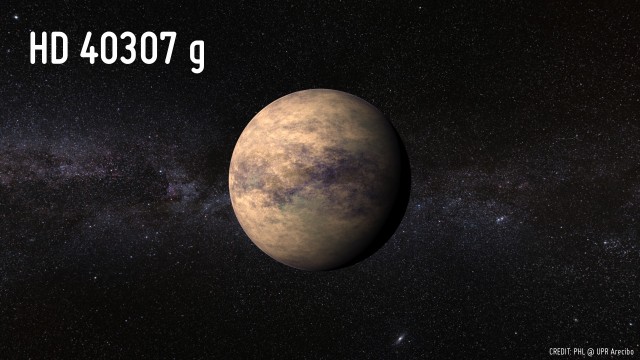
A reanalysis of old data obtained by an Earth-based observatory has found what seems to be the signal of a large planet, somewhere between the mass of Earth and Neptune, orbiting a dwarf star about 42 light years from Earth. It's part of a crowded system of six planets, but appears to be the only one of them that's in the host star's habitable zone. And, according to the people who have identified it, the planet should be close enough to Earth to be imaged directly by some of the observatories currently in the planning stages.
The star in question is HD 40307, which is only about three-quarters the mass of the Sun, and quite a bit dimmer. The star has been targeted for observations using the HARPS, the same instrument that recently spotted the signal of an exoplanet in the Alpha Centauri system. The instrument looks for periodic changes in the light emitted by the star. These arise from Doppler shifts caused by its orbiting planets, which periodically pull the star in different directions.
The HARPS team had already analyzed data from HD 40307, and determined that there were three planets apparent in the data obtained by the instrument. But now, an international team of researchers has gone back and reanalyzed the data using a number of different methods. Their work suggests there are at least six planets in the system.
The HARPS method of finding planets is extremely sensitive to noise, since things such as the star's rotation can also cause periodic changes in the light we receive from it. For short-term changes, the initial HARPS analysis simply combined a series of measurements taken at short intervals, figuring that any noise should average out.
The new analysis relies on a revised data set, obtained after a potential source of error in the HARPS measurements was identified and accounted for. It also skips merging the data, and uses a somewhat different statistical method to analyze matters.
After identifying and eliminating a couple of sources of periodic noise—including the star's rotation and its activity cycle—the authors set down to identifying signals from any orbiting planet. The technique they use is pretty standard in papers like this: identify the signal of one orbiting planet, remove it, and look for whether any additional signals are left. Signals are identified by modeling the effect you'd see by having planets of various masses orbit at all possible distances out to a limit.
As you might expect, the initial three planets spotted by HARPS created clear signals in the data. As they were removed, however, additional signals kept becoming apparent, with orbital periods at 34, 51, and 320 days. Using unmerged data, this six planet version of the system was far more probable than the three planet one that had been originally proposed.
But the researchers weren't done yet. Variations in light emitted by the star are more pronounced at shorter wavelengths than at longer ones (towards the red end of the spectrum and beyond). So to avoid some of the noise, they went back and reanalyzed the unmerged, noise-corrected HARPS data, focusing on the red end of the spectrum this time. The same 34 and 51 day signals were still there, but now the 320 day signal was weaker, replaced by one at 200 days. It turns out that, due to the periodicities involved, these two signals can partially overlap, and the authors suggest that a combination of noise and the signals' similarity led to the initial, mistaken identification.
That shift in distance makes a dramatic difference, as a 200 day orbit places the planet squarely in the zone expected to have liquid water. Because of the relative dimness of the host star, the habitable zone is quite a bit closer in than it is near the Sun, covering between 0.43 and 0.85 Astronomical Units (the typical distance between the Earth and Sun).
The planet itself is about seven times the mass of Earth, placing it in an awkward position between being a super-Earth (a massive, rocky body) and a mini-Neptune, which is a watery/gaseous body. Without knowing more about the planet, it's tough to discriminate between these choices. They suggest that planetary modelers might want to consider the conditions that would prevail there for both of these options.
They also note that several telescopes that are in the planning stages would be able to resolve the planet (assuming they go forward), and will be able to potentially tell us something about their composition. In the mean time, follow up observations should give us a better sense of whether the signal identified in this reanalysis is actually caused by a planet. It took a lot of statistical effort to reveal it, and the authors' own calculations suggest that this tightly packed system of six planets would only be stable under a limited number of scenarios (nearly circular orbits, limited mass ranges of the planets, etc.) So, although the analysis the authors did here is perfectly reasonable, it would be nice to see it hold up when further data comes in.
Astronomy & Astrophysics, 2012. DOI: Not yet available.
reader comments
45